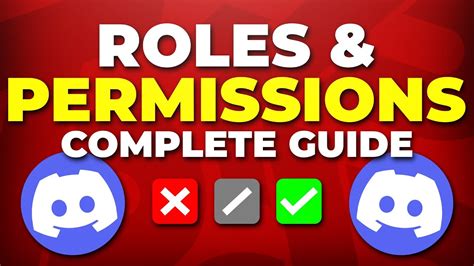Understanding Discord Permissions and Roles

What are Discord permissions?
Discord is a popular communication platform that offers a wide range of functionalities for users to connect and interact with each other. One essential aspect of Discord is the concept of permissions, which plays a significant role in controlling and managing user access and actions within a server.
Discord permissions determine what a user can and cannot do within a server. These permissions are assigned to roles, which can then be assigned to individual users or groups of users. By setting permissions, server administrators can ensure that certain actions such as editing channels, managing members, or sending messages are only performed by trusted individuals or specific roles.
There are various types of permissions that can be assigned to roles in Discord. Some common permissions include:
- Create Instant Invite: This permission allows users to generate instant invites, making it easier to invite others to join the server.
- Kick Members: Users with this permission can remove other members from the server.
- Ban Members: This permission grants the ability to ban users from the server, preventing them from rejoining.
- Manage Channels: Users with this permission can create, delete, or modify channels within the server.
- Manage Roles: This permission enables the management and modification of roles within the server.
- Manage Server: Users with this permission have access to server-wide settings, including deleting the server itself.
| Permission | Description |
|---|---|
| Create Instant Invite | This permission allows users to generate instant invites, making it easier to invite others to join the server. |
| Kick Members | Users with this permission can remove other members from the server. |
| Ban Members | This permission grants the ability to ban users from the server, preventing them from rejoining. |
| Manage Channels | Users with this permission can create, delete, or modify channels within the server. |
| Manage Roles | This permission enables the management and modification of roles within the server. |
| Manage Server | Users with this permission have access to server-wide settings, including deleting the server itself. |
By leveraging these permissions and assigning them accordingly, server administrators can ensure the smooth functioning of their Discord server while maintaining security and control. It is important to carefully consider the roles and permissions assigned to each user to maintain a well-organized and secure community.
Different types of roles in Discord
In Discord, different types of roles play a crucial role in managing a server and maintaining order among members. Roles in Discord are like hierarchical groups that allow server owners and administrators to assign specific permissions and privileges to different members based on their roles. These roles help to organize and control the activities and interactions within the server. Understanding the different types of roles available in Discord is essential for effective server management and creating a positive user experience.
1. @everyone Role: This is the default role assigned to every member who joins a Discord server. By default, @everyone has minimal permissions and can only access and read the channels visible to them. Server owners and administrators can customize permissions for this role, but it is generally advised to limit its privileges to maintain server security and prevent spam.
2. Custom Roles: Along with the @everyone role, Discord provides the flexibility to create custom roles tailored to your server’s needs. These roles allow you to define specific permissions for different members. Custom roles can be created for various purposes, such as moderators, administrators, members with special privileges, or even role-specific gaming teams. Assigning members to these roles helps in streamlining server management and ensuring smooth communication and collaboration.
3. Role Hierarchy: Discord follows a role hierarchy system to determine which role’s permissions take precedence. This ensures that higher roles have additional privileges and can manage lower-ranked roles effectively. For example, if a member belongs to both the “Administrators” and “Moderators” roles, the permissions assigned to the “Administrators” role will override the permissions granted by the “Moderators” role. Role hierarchy provides a structured approach to assigning and managing permissions within a server.
Using a combination of these role types can significantly enhance the functionality and organization within a Discord server. It is crucial to carefully define and assign roles based on the responsibilities and requirements of your server’s members. Regularly reviewing and updating roles ensures that the right individuals have the appropriate permissions to perform their tasks, maintaining the harmony and integrity of the server environment.
In conclusion, roles in Discord serve as an effective tool for server management and user engagement. Understanding the different types of roles available, such as @everyone, custom roles, and role hierarchy, is essential for creating a well-structured and organized server. By assigning roles and managing permissions effectively, server owners and administrators can ensure a smooth and enjoyable experience for all members within the Discord community.
How to assign roles and permissions
Discord is a popular platform used by gamers, communities, and businesses alike for communication and collaboration. One of the key features that makes Discord so versatile is its role and permission system. Roles allow you to define a set of permissions for a group of users, making it easier to manage and control access to different features and channels within a server. In this blog post, we will explore how to assign roles and permissions in Discord.
Assigning roles in Discord is a straightforward process. To begin, you need to have administrative or moderator privileges on the server. Once you have the necessary permissions, you can follow these steps:
- Create Roles: The first step is to create the roles that you want to assign. Roles can have various names, colors, and permissions associated with them. To create a role, go to your Discord server settings, click on the “Roles” tab, and then click on the plus button to create a new role. Once you have created the role, you can customize its permissions.
- Edit Permissions: After creating the roles, you can now edit the permissions associated with each role. Discord provides a comprehensive list of permissions that you can enable or disable for each role. Some common permissions include the ability to send messages, manage channels, kick or ban members, and more. It’s important to carefully consider the permissions you grant to each role, ensuring that they align with the responsibilities and access levels required.
- Assign Roles: With the roles and permissions set up, you can now assign roles to individual users. To do this, go to the server settings, click on the “Members” tab, and find the user you want to assign a role to. Click on the “Add Role” button and select the desired role from the list. The user will now have the assigned role and inherit the associated permissions.
By assigning roles and permissions in Discord, you can effectively manage user access and ensure that the right people have the right level of control and privileges within your server. This is particularly essential for large communities, where maintaining order and security is crucial.
In conclusion, Discord’s role and permission system provides a powerful tool for server owners and administrators to manage user access and control within their servers. By following the steps outlined in this blog post, you can easily assign roles and permissions, allowing for a more secure and organized Discord community.
Managing user permissions in Discord
Managing user permissions is an important aspect of maintaining a well-structured and organized server on Discord. With an increasing number of users joining communities and interacting on the platform, it is crucial to have proper control over permissions to ensure a safe and enjoyable experience for everyone. In this blog post, we will explore the various features and tools available on Discord that allow you to manage user permissions effectively.
Discord offers a flexible and comprehensive system for managing user permissions. It allows you to assign different roles to users, each with its own set of permissions. These roles act as a way to categorize users based on their responsibilities and access levels within the server. By assigning roles, you can easily control what actions users can perform, what channels they can access, and more.
One of the most powerful features of Discord is the ability to customize permissions for each individual role. This gives you fine-grained control over what specific actions a user can take on the server. Whether it’s the ability to kick or ban members, manage channels, or even send messages, you can tailor the permissions to suit your needs. By utilizing this feature, you can ensure that only trusted and responsible individuals have access to certain functions.
- Manage Roles: As a server administrator, you have the ability to create, edit, and delete roles. This allows you to customize your server’s hierarchy and grant permissions accordingly. You can create roles that reflect different levels of authority or responsibility within your community.
- Assigning Roles: Once you have created roles, you can assign them to users. This is done by simply selecting the user and assigning the desired roles to them. Users can have multiple roles, and their permissions will be a combination of all the roles they possess.
- Setting Channel Permissions: Discord also allows you to set permissions for each individual channel. This means that you can control who can view, send messages, manage the channel, and much more. By setting specific channel permissions, you can create private or restricted areas within your server.
| Permission | Description |
|---|---|
| Create Instant Invite | Allows the user to generate an instant invite link for the server. |
| Kick Members | Grants the user the ability to kick members from the server. |
| Ban Members | Grants the user the ability to ban members from the server. |
By utilizing the powerful role and permission management features offered by Discord, you can effectively manage the user permissions in your server. This ensures that your community remains organized, secure, and enjoyable for all members. Remember to regularly review and update permissions as your server grows and evolves, and always communicate any changes or updates to your members to maintain transparency. With proper user permission management, you can create a thriving and engaging community on Discord.


